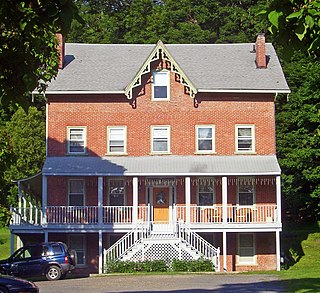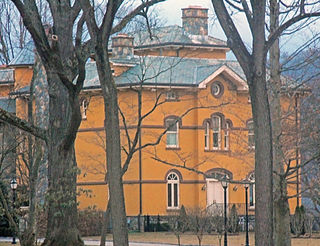
Calvert Vaux was an English-American architect and landscape designer, best known as the co-designer, along with his protégé and junior partner Frederick Law Olmsted, of what would become New York City's Central Park.

Andrew Jackson Downing was an American landscape designer, horticulturist, and writer, a prominent advocate of the Gothic Revival in the United States, and editor of The Horticulturist magazine (1846–52). Downing is considered to be a founder of American landscape architecture.

Eustatia is a brick house overlooking the Hudson River in Beacon, New York, United States. Located on Monell Place in the northwestern corner of the city, it is a rare survival in Beacon of a cottage in the High Victorian Gothic style.

Frederick Clarke Withers was an English architect in America, especially renowned for his Gothic Revival ecclesiastical designs. For portions of his professional career, he partnered with fellow immigrant Calvert Vaux; both worked in the office of Andrew Jackson Downing in Newburgh, New York, where they began their careers following Downing's accidental death. Withers greatly participated in the introduction of the High Victorian Gothic style to the United States.

The Dodge-Greenleaf House is on NY 211 in Otisville, New York, United States. It was built circa 1855 in the Gothic Revival style. The architect is unknown but it exemplifies contemporary trends in home design popularized by the writings and pattern books of Andrew Jackson Downing of nearby Newburgh, as articulated in the Picturesque mode.

The Birches is a house at the southeast corner of the junction of NY 9D and 403 in the hamlet of Garrison, New York, United States. It was built for William H. Osborn, as part of his nearby Wing & Wing estate, by architect Ralph Adams Cram in the Gothic Revival architectural style. Osborn was a 19th-century railroad tycoon, who became one of the most prominent railroad leaders in the United States. In addition to Wing and Wing and the Birches, Osborn famously constructed Castle Rock, his great summer estate overlooking the Hudson River.

The Dutchess Company Superintendent's House is a home located on Market Street in the western corner of the village of Wappingers Falls, New York, United States. It is a large brick residence that was built as housing for the manager of the Dutchess Company, a large local printing works, shortly after the plant was built in 1848.

The William Shay Double House is a residential duplex at Point Street and River Road in New Hamburg, New York, United States. It was built around 1870 and added to the National Register of Historic Places in 1982.

Montrest is a house on Lane Gate Road outside Nelsonville, New York, United States. It was built after the Civil War as a summer residence by Aaron Healy, a successful New York leather dealer, to take advantage of panoramic views of the Hudson River and surrounding mountains of the Highlands.

The building at 73 Mansion Street in Poughkeepsie, New York, United States, was first built around 1890 as a single-family residence. It is next to the city's post office and across from the offices of the Poughkeepsie Journal, at the corner with Balding Avenue.

The William H. Rose House is located on Tomkins Avenue in Stony Point, New York, United States. It is an ornate Carpenter Gothic-style house from the mid-19th century, with similar outbuildings, built for a wealthy local businessman.

Echo Lawn Estate, also known as Stonegate after the Great War, is a historic estate located at Balmville in Orange County, New York. The main house was built about 1860 and is a two-story brick dwelling in the Second Empire style. It features sweeping concave mansard-type roofs. Also on the property is a cluster of mid-19th-century service buildings, an early 20th-century formal garden, and a substantial set of Arts and Crafts inspired gateposts and stone walls.

Rock Lawn is a historic house in Garrison, New York, United States. It was built in the mid-19th century from a design by architect Richard Upjohn. In 1982 it was listed on the National Register of Historic Places along with its carriage house, designed by Stanford White and built around 1880.

The Richard Austin House is located on Croton Avenue in the village of Ossining, New York, United States. It is a wood frame structure dating to the 1870s. In 1989 it was added to the National Register of Historic Places.

The North Grove Street Historic District is located along the north end of that street in Tarrytown, New York, United States. It consists of five mid-19th century residences, on both sides of the street, and a carriage barn. In 1979 it was listed on the National Register of Historic Places.

The Delavan Terrace Historic District is located along the street of that name in Northwest Yonkers, New York, United States. It consists of 10 buildings, all houses. In 1983 it was recognized as a historic district and listed on the National Register of Historic Places.

The W. E. Warren House is a historic house located at 196 Montgomery Street in Newburgh, New York. It is a focal point of the Montgomery—Grand—Liberty Streets Historic District, one of several houses in the area built by Calvert Vaux. A historical marker for Vaux's friend and partner Andrew Jackson Downing is located outside the house.

The Joel T. Headley House is a historic mansion in New Windsor, New York, built for historian and writer Joel T. Headley (1813–1897), who later served as a New York State Assemblyman for Orange County and the New York Secretary of State (1856–1857). Headley commissioned the house and grounds from local architectural theorist and landscape designer Andrew Jackson Downing with assistance from his partner, English architect Calvert Vaux. Subsequent owners were unaware of the house's significance until the 1990s, and fervor for Downing and Vaux in neighboring Newburgh often neglects its existence. The design, No. 14 "A Cottage in the Rhine style" featured in a later edition of his book Cottage Residences, also inspired the William G. DeLuc House in Minnesota, considered a rare example of Gothic-inspired architecture there.

The Halsey Stevens House is a historic house located at 182 Grand Street in Newburgh, New York. It is one of the first residences designed by the architects Calvert Vaux and Frederick Clarke Withers after the death of their mentor Andrew Jackson Downing the previous year. Listed as part of the Montgomery—Grand—Liberty Streets Historic District in Newburgh, the house has been well-preserved and demonstrates how both worked with Gothic Revival and Italianate styles. Halsey R. Stevens, their client, was a lumber dealer and Biblical scholar.

The Eugene A. Brewster House is a historic house located at 264 Grand Street in Newburgh, New York. Built in 1865, the year Newburgh incorporated as a city, it was designed by English immigrant architect Frederick Clarke Withers for attorney Eugene Augustus Brewster. It is the last residence Withers designed in Newburgh, where he began his career as a practicing architect in the mid-1850s.
























